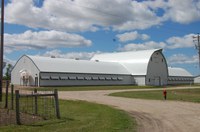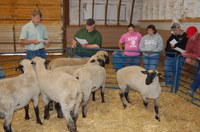NDSU Sheep Unit Aids Research, Education
(Click an image below to view a high-resolution image that can be downloaded)
-

NDSU's Sheep Unit recently completed a multiyear remodeling project. -

NDSU Extension Service sheep specialist Reid Redden, left, and Sheep Unit manager Skip Anderson (center) talk to sheep producers about a national performance-based genetic evaluation program for sheep during a recent open house at the NDSU Sheep Unit.
On an ordinary-looking farmstead west of the North Dakota State University campus, researchers are hoping to find answers to improve sheep production, not just in North Dakota but throughout the U.S.
NDSU’s Sheep Unit also has two other roles: Extension Service specialists use it to share what the researchers have learned with producers and others in the sheep industry through open houses, field days, tours and other educational programs, and students in NDSU’s animal sciences courses receive hands-on experience in working with livestock. In addition, the unit has hosted artificial insemination schools and major events such as the 2007 International Katahdin Expo, which attracted participants from 24 states and four other countries.
“We try to do projects here that are producer-friendly, that let us disseminate the information that producers can put into use immediately in their sheep operations,” says Sheep Unit manager Skip Anderson.
One project involves evaluating a commercially available pregnancy detection and litter size test.
“Identifying which ewes are pregnant and the litter size is very important because the ewes’ nutrient requirements are drastically different during late gestation and lactation,” NDSU Extension sheep specialist Reid Redden says. “By removing nonpregnant ewes and sorting ewes into groups based upon litter size, sheep producers can maximize the use of resources such as feed, labor and facilities while improving flock health by feeding the ewes what they need and when they need it.”
Researchers also are testing a recently approved product designed to improve out-of-season breeding.
“Ewes typically are bred to lamb from February to June,” Redden explains. “However, this causes a problem in the industry because there is often a shortage of lambs at certain times of the year. Sheep producers who can lamb in the fall and early winter typically receive a premium for their lambs because the lambs are marketed when the supply is low.”
The Sheep Unit also is breeding for sheep that lamb naturally out of season. These genetics ultimately will be made available for sheep producers in the region to purchase.
Another way the Sheep Unit is helping producers is by enrolling three of the unit’s flocks in the National Sheep Improvement Program (NSIP), a performance-based genetic evaluation program designed to help sheep producers choose breeding stock with the best genetics. Programs such as this for other livestock species have proven to be the best method of identifying animals that excel in commercially important traits, but few sheep have been enrolled in the NSIP, Redden says. Based on NDSU’s experience, he’ll be able to inform North Dakota sheep produces about how the program works and how it can benefit them.
NDSU recently completed a multiyear remodeling project at the Sheep Unit. That included upgrading the lambing facility and the main barn’s ventilation, regrading and landscaping the pen area to improve drainage, adding a fence line feeding system, reroofing the main barn, and replacing windows and lighting. The main barn was built in the 1940s, and two other structures for housing sheep and an equipment storage building were added later.
Anderson says the fence line feeding system was a good addition. Workers place the feed along the fence outside of a pen, which means they don’t need to go inside pens to feed the sheep and they can use a variety of equipment to deliver feed to the fence line. Having the sheep eat through the fence also reduces feed waste.
“This allows us to manage sheep in different pens, and monitor feed intake and feed usage,” he adds.
The unit has four purebred flocks: Hampshire, established in 1915; Columbia, established in 1945; Katahdin, introduced in 1999; and Dorset, added in 2008. In all, the unit is home to 300 mature breeding ewes and about 15 rams.
“In 2011, every mature breeding female was utilized on a research project, with many being used in multiple projects,” Anderson says.
In the Sheep Unit’s academic role, it serves as a classroom for students in a variety of courses, including animal science, behavior and handling, as well as judging and evaluation, and the Veterinary Technology program. But it’s no ordinary classroom.
“I require the students to get dirty to put them in a situation where they are working with animals and seeing what a shepherd does on a daily basis,” Anderson says.
This facility is a huge asset, according to Alison Crane, a graduate research assistant in NDSU’s Animal Sciences Department. Crane, of Warrior, Ala., is working on a master’s degree in animal science.
“The way sheep are raised in this region versus the South is dramatically different, and learning those differences has been most valuable to my life goals and shaping a career for me,” she says.
Anderson has three goals for the Sheep Unit: continue to be a leader in research that directly affects producers, use new technology to produce efficient and healthy sheep, and continue to provide a place for students to receive hands-on experience.
“And we still want to uphold the tradition of what the NDSU Sheep Unit has been all about,” he says.
NDSU Agriculture Communication - Sept. 28, 2012
| Source: | Skip Anderson, (701) 356-3295, steven.e.anderson@ndsu.edu |
|---|---|
| Source: | Reid Redden, (701) 231-5597, reid.redden@ndsu.edu |
| Editor: | Ellen Crawford, (701) 231-5391, ellen.crawford@ndsu.edu |

